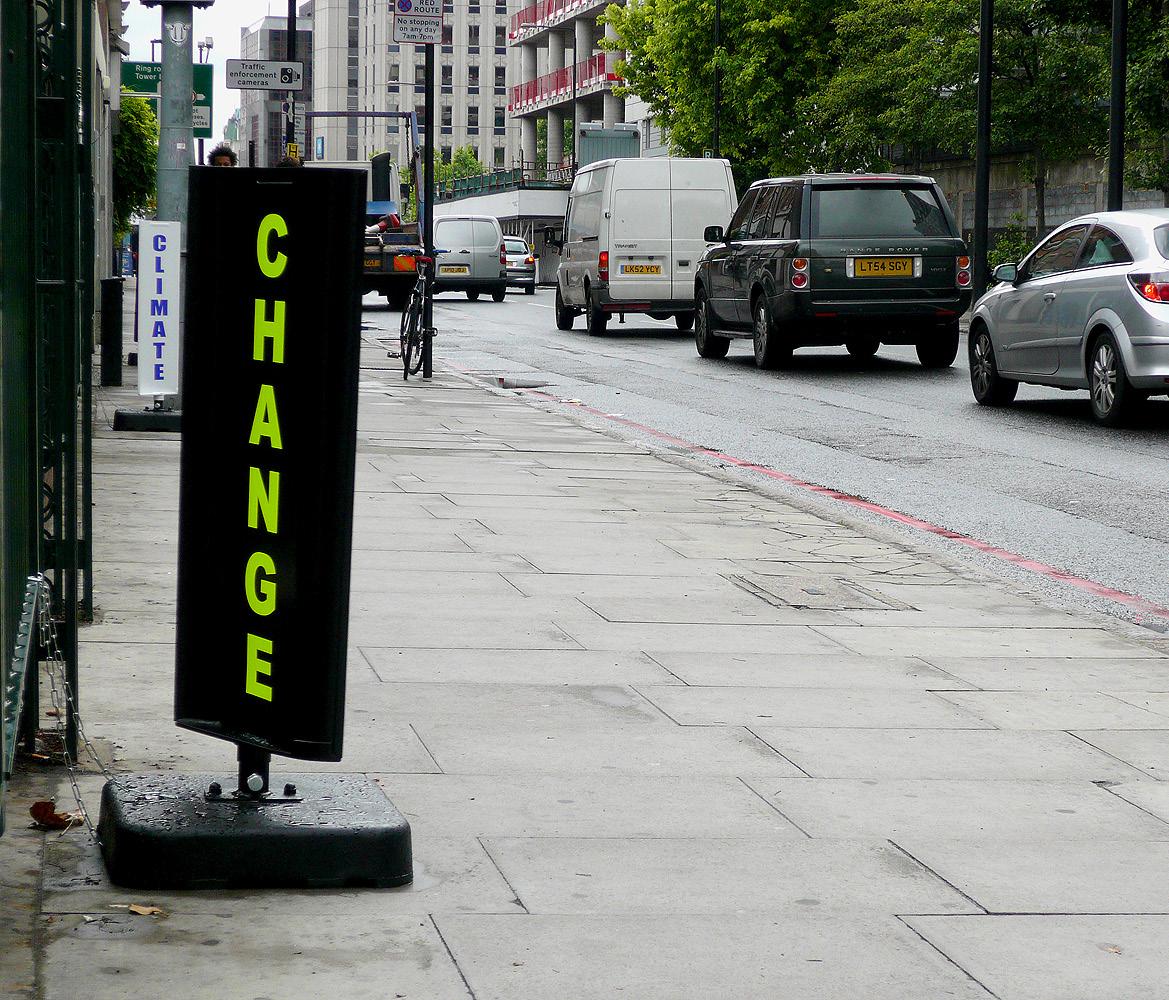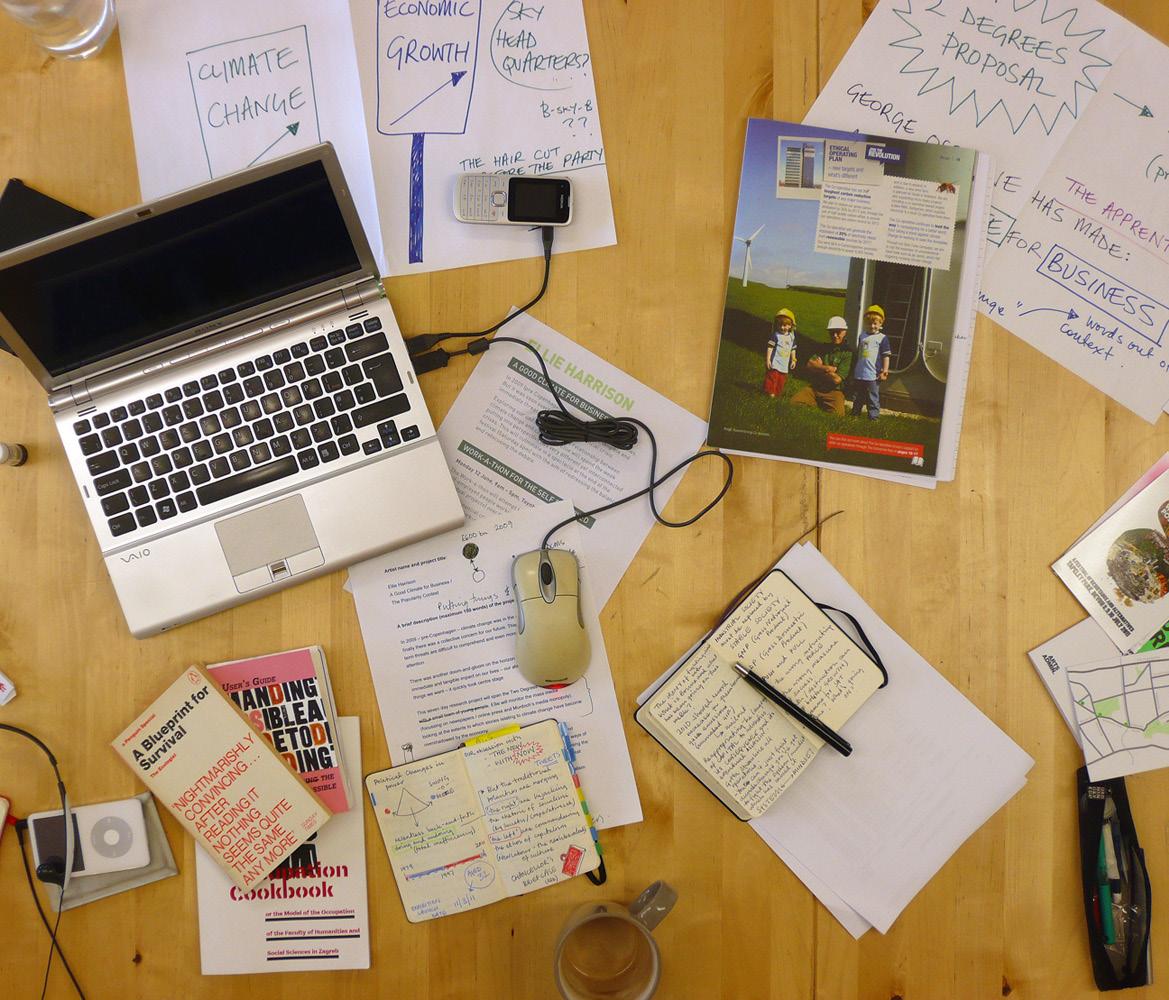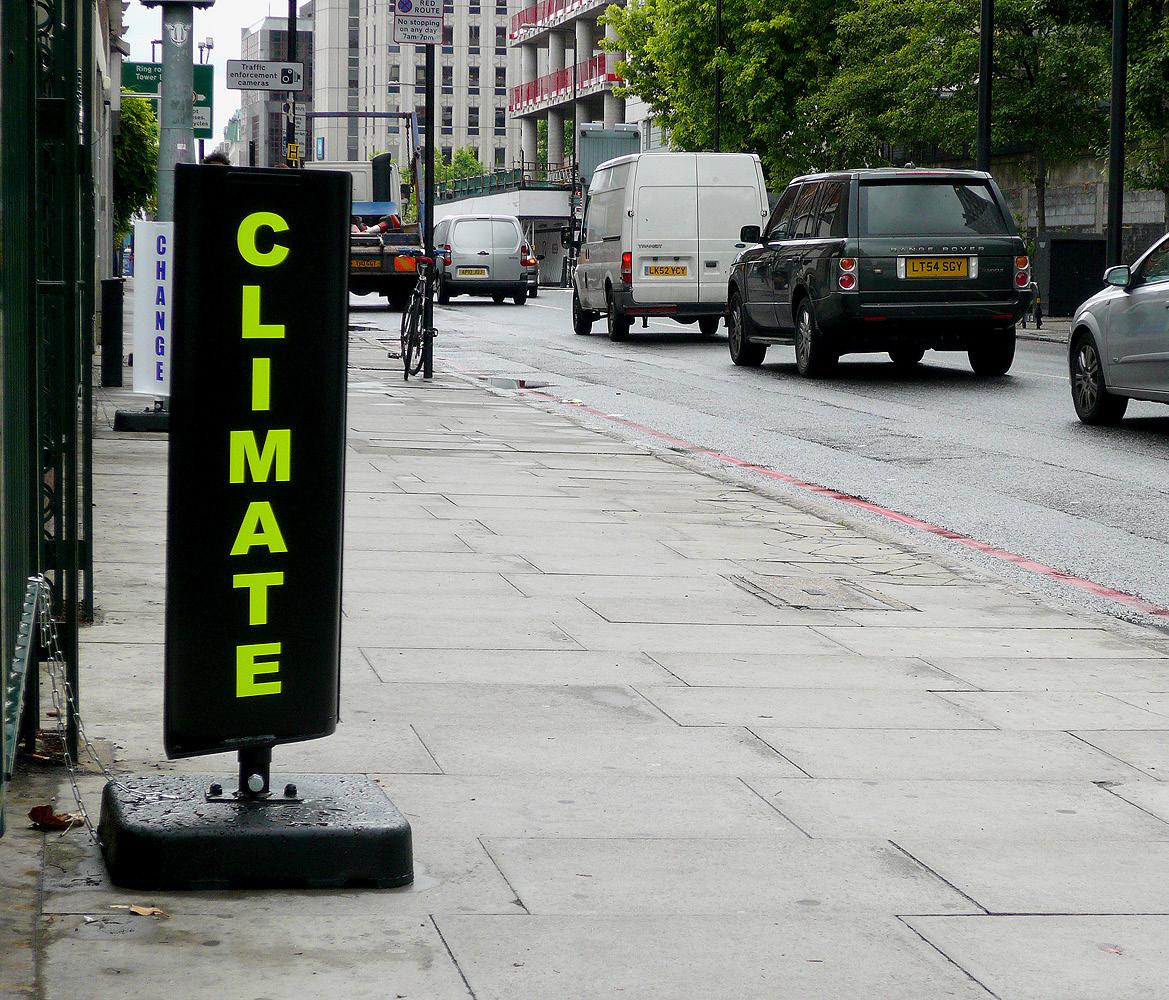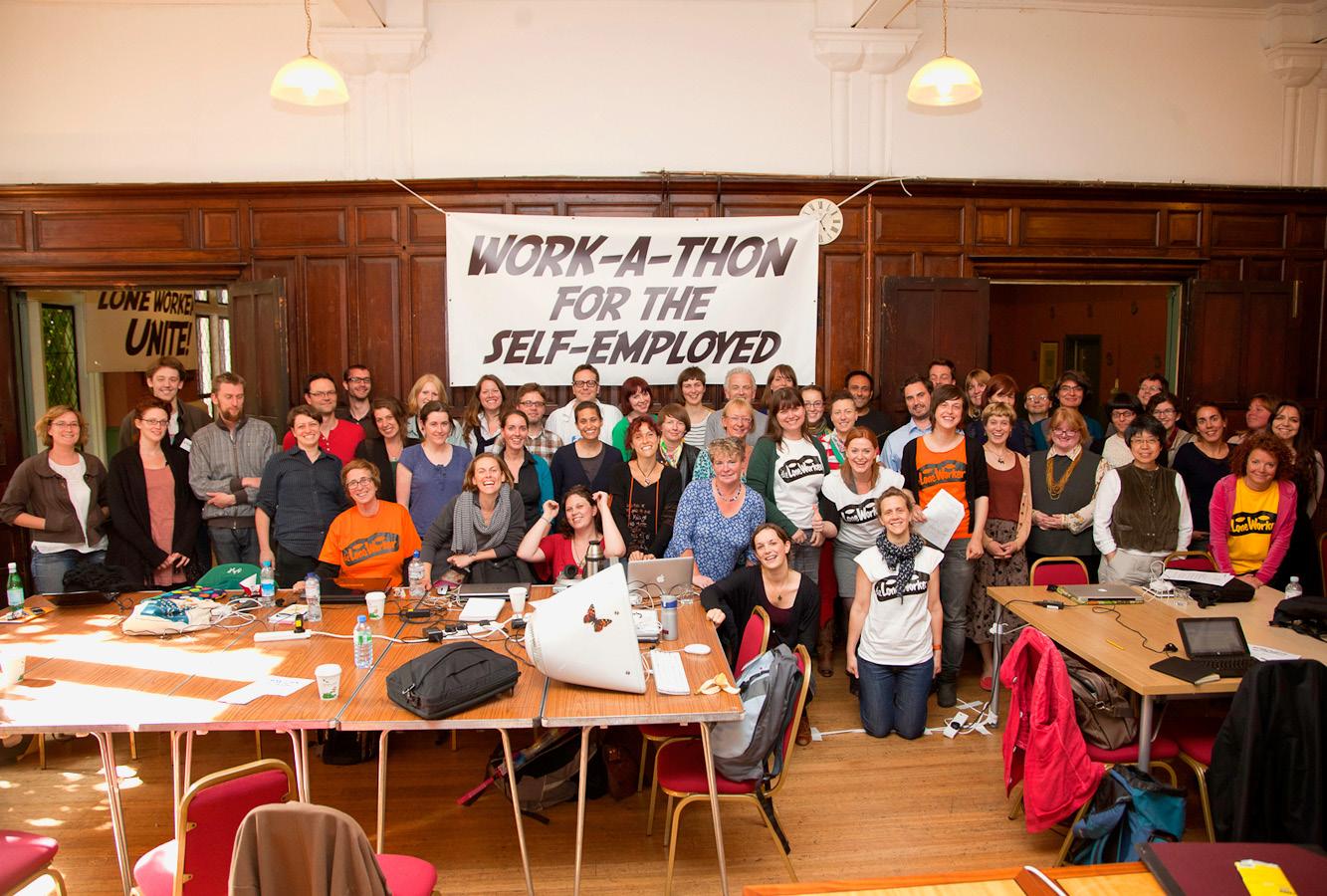

Ellie Harrison A Good Climate for Business
Ellie Harrison A Good Climate for Business
From 12 - 18 June 2011, Ellie Harrison was resident artist at Artsadmin’s Two Degrees. Responding to the themes of ‘art and activism, climate and cuts’ she developed two new projects for the festival. The first, Work-a-thon for the Self-Employed, took place on Monday 13 June and was an attempt to set a new world record for the most self-employed people working together in the same place at the same time, over the course of a normal 9-to-5 day. The second was a research project under the banner of ‘A Good Climate for Business’ which aimed to explore the relationship between capitalism and climate change and resulted in the development of her Early Warning Signs project.
This, her guest text for the Artsadmin website, aims to provide a context for these works by summarising her thoughts in the run-up to the festival and showing how they developed in response to the week’s events.

Ellie Harrison’s temporary studio in the Meeting Room at Toynbee Studios
I hadn’t set myself the easiest of tasks - ‘researching and exploring our understanding of the relationship between climate change and capitalism’. It seems
that the possibility of finding a happy union between the ‘sustainability’ required to avert climate catastrophe and the ‘economic growth’ demanded by capital is by far the greatest conundrum of the twentyfirst century. This is why, I think, it is such a pertinent issue for artists (and everyone else) to be addressing.
This also explains why I spent numerous hours sat in my temporary studio during Two Degrees overwhelmed and slightly confused about what one artist, or one activist for that matter, could do to attempt to tackle it...
We all know that the more we buy, the more we consume, the more we produce, the more we deplete the world’s resources and contribute to the global CO2 emissions which are causing our climate to change. This is not new news. In fact, the 1972 book ‘A Blueprint for Survival’, which I brought to the festival with me, succinctly defines the problem: “Indefinite growth of whatever type cannot be sustained by finite resources. This is the nub of the environmental predicament.”1
But despite this very rational-sounding prediction, made nearly forty years ago, the capitalist machine has not been halted. It marches on with our reluctant complicity: continuing to expand both geographically and to the extent that market
logic is increasingly permeating every last aspect of our lives2. Just two weeks before Two Degrees kicked-off, figures were released showing that global emissions for 2010 had reached a record high, demonstrating that “the link between rising GDP and rising emissions has [still] not been broken.”3
Why are we, as of yet, unable to break the link which causes ‘economic growth’ to have such self-destructive consequences? Or, better still, why are we unable to break away from the system and the mindset of capitalism which places such an irrational goal at the top of all the world’s priorities?
My first step was to admit to my own ineptitude at solving this conundrum, if indeed it is possible. My next was to use my week at Two Degrees to begin to think about the nature of the contradiction that appears to exist between the demands of ‘sustainability’ and ‘growth’. I began to notice an interesting parallel with the other key theme of the festival and with my own personal experience of the (sometimes) contradictory demands and motivations of being pushed and pulled between the roles of ‘artist’ and ‘activist’, between ego and altruism.
At the very least my week at Two Degrees enabled me to analyse my own behaviour, to think about my own priorities and about how I have been, and how I should be, spending my time. Maybe this is self-indulgent, but I’m now slowly coming to realise that reconciling these contradictions on a personal level is, perhaps, where the key to resolving our global predicament actually lies.

Warning Signs installed on Commercial Street during Two Degrees
In the run-up to Two Degrees I was almost entirely in ‘artist’ mode. I was under pressure (some self-imposed), to create something visually stunning - a ‘spectacle’ - to sum-up this allimportant research. Not much more than a week before I set off for London I came up with the idea for the Early Warning Signs. It was simple: to utilise the brazen marketing techniques of capitalism, not as tools to sell us more, but as tools to remind us of the consequences of our consumption. The aim was to ‘advertise’ climate change: to put the issue back into the public consciousness, from which it has long since been sidelined by the dreaded financial ‘cuts’ and other short-sighted concerns.
Throughout Two Degrees, the four signs designed to mimic those you might find outside a garage or a Bureau de Change, took up residence along Commercial Street - inspiring, provoking and confusing passers-by to varying degrees. One bemused tourist actually did come all the way into Toynbee Studios asking to exchange some currency and, one morning as I was putting the signs out on the street, an arrogant businessman stuffing a croissant into his mouth heckled “so much for climate change” as the uncharacteristic June rain poured down around us.
They provoked thought and / or physical reaction. The signs were a success! They may not have fitted the bill of the grand ‘spectacle’, but they looked good; they acted as beacons for the festival and they ticked the box of one of Larry Bogad’s top tips for ‘tactical performance’ (recounted in his lecture on 18 June), by “drawing on existing signs and signifiers and inverting them”. And yet despite all this, all week I could not help feeling slightly compromised by their existence. I was embarrassed by their unequivocal materiality. Confronted on a daily basis by their objectness, I became overwhelmed by a ‘guilt of production’ that perhaps only an environmentally-concerned artist can.
In February 2010, I had become the selfdeclared ‘first individual artist to openly publicise an Environmental Policy’ on my website. The fourth section of the policy entitled ‘Reduce, Reuse, Recycle’ presents my guidelines for producing what I term as ‘gallery based work’ (loosely categorised as work which takes a more conventional form, i.e. an object / collection of objects that take up space in the real world). It is my publicised goal to “attempt to use objects or materials which are either temporarily loaned or secondhand from local sources or eBay.”
It was therefore ironic (and disappointing) that it was for Two Degrees - the first art project I’d been involved in that was actually acknowledging / dealing with the climate crisis - that I had been forced to compromise this policy. It was for Artsadmin - one of the few artworld institutions I’m aware of that has actually begun to take the threat of climate crisis seriously - that I was forced to spend more than £480 having four brand new rotating signs produced and delivered (at short notice) by the RotoSigns Company in the West Midlands.
It was a compromise indeed: a contradiction, and so acknowledging and exploring the circumstances further seemed the logical next step. Not only had the production of the signs presented me with a real and tangible problem - what to do with them after the festival - which it could then become my main mission to solve, but, in unpicking the reasons why I was forced to compromise I found the key to tying together my research with my other contribution to the festival - the Work-athon for the Self-Employed.

Most of the 57 workers who came together to set a new world record on 13 June 2011
